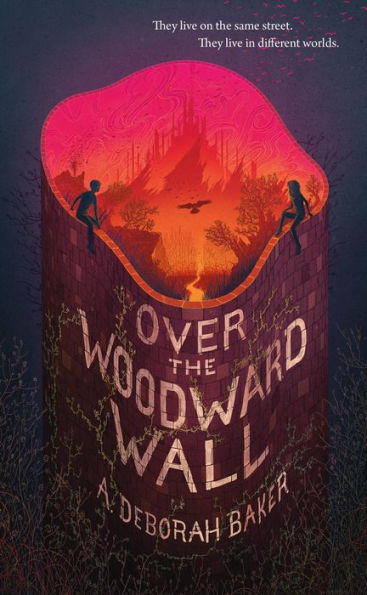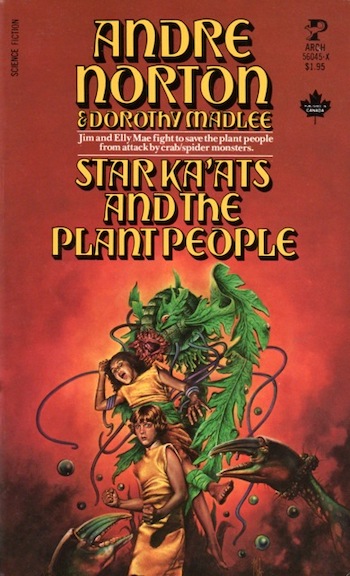As awesome sffnal titles go, The Wonderful Flight to the Mushroom Planet is just about the pinnacle. But you have to admit, Star Ka’ats and the Plant People is right up there. It has SFF written all over it. And randomly apostrophized alien cats. And plant people.
This is the third volume of Norton and Madlee’s middle-grade series about kitties in space. This time around, intrepid human kids Jim and Elly are helping the Ka’ats explore the city of the alien humanoids who, here, are called the People. There is a crisis brewing: the Ka’ats are running out of metal to manufacture their machines, especially the flying machines.
Jim and Elly and their Ka’at friends meet the crisis up close and personal when their flyer makes a forced landing. The flyer has worn out, and there are very few working flyers left. Somehow, the Ka’ats and the kids have to find out where the People mined their metal. And they have to do it soon, before the existing stock runs out.
The kids, as usual, have both assets and liabilities relative to the Ka’ats. They’re not very good at telepathy, and they struggle sometimes to make themselves understood. But they also have hands, and they’re similar enough to the People that they can penetrate protective barriers that close off the People’s installations to the Ka’ats. Then, once they get there, they can figure out how to work the machines.
This episode once again shows how human skills and knowledge prove indispensable to the Ka’ats, and once again, Jim and Elly save the world. They follow an ancient track—which Jim figures out is a kind of monorail—to an abandoned port, where they find a large store of metal objects. But that’s clearly not where the metal came from.
That is somewhere across the sea. Elly is the one who breaks the code: she picks up a mental distress call from an island hidden in fog. This island has similar defenses to the original city, and is equally penetrable to the kids, once they manage to find a seaworthy boat. Jim just naturally assumes he’ll drive, and Elly doesn’t make any move to argue.
Which is sexist in a Seventies sort of way, but as those things go, it’s fairly minor.
The island is classic Norton: long-lost machines in underground installations, humans who have to figure them out before the monsters take over, and weird indigenous life. In this case, the monsters are swarms of crablike things that are kept away from the island by the forcefield until Jim shuts it down to let the Ka’ats in, and the good-guy aliens are water plants. It was one of these being devoured by crabs that Elly picked up, and another one both rescues the kids and is rescued by them.
The answer to the question of the People’s metal is the plant people. They produce metal from enriched water, and the People lured them to the island by the emission of, basically, fertilizer. They are definitely sentient: they have emotions, they make plans, they undertake to rescue the kids from the crabs.
Rather ironically, they broadcast on a mental frequency that the Ka’ats can’t pick up at all, but the kids do it easily. The Ka’ats find themselves in the position of needing humans to serve as interpreters. Meanwhile the kids continue to manipulate the machines in ways that the Ka’ats can’t, because hands. They’re an essential interface between the Ka’ats and the machines they need to maintain their culture.
Buy the Book


Over the Woodward Wall
There is one thing however in which the two species can fully and equally collaborate, and that’s to make horrible noises that drive off the crabs. The machines need human words and voices, but the crabs respond to pitch and volume. And cats, as we all know, can make truly horrendous noises when sufficiently motivated. I love the idea of scout units of cats with epic vocal talents, patrolling the island and protecting it from the hungry swarms.
That’s such a kid way to solve a dangerous problem, and it’s lovely. So are the plant people, who produce metal in a non-damaging, non-exploitative way, in return for rich food and safety from the crabs. It’s a much better solution than mining, more natural and literally organic, and it’s sustainable, which makes it even more timely for 2020 than for 1979.
The tech here is also less retro and more contemporary. It’s pretty much straight out of Star Trek from a decade before: a tablet with a stylus, and a computer table that works with the insertion of color-coded blocks. These blocks open surveillance channels to various areas including the port and various parts of the island, and a kid at command central can communicate with whoever is on the other end.
Usually Norton’s tech, even by the Seventies, feels as if it’s locked into the Fifties. Maybe it’s Madlee’s influence, or else Norton herself was starting to open up a bit. It’s less quaint here and more modern, with more of a sense of the ways in which computers have come to control just about everything.
Though we haven’t mastered telepathy yet, and we haven’t managed to grow metal instead of mining it. Maybe that’s in our future still.
I’ll finish off the series next time with Star Ka’ats and the Winged Warriors. Back to space again, and giant killer insects, aaaaaaa!
Judith Tarr’s first novel, The Isle of Glass, appeared in 1985. Since then she’s written novels and shorter works of historical fiction and historical fantasy and epic fantasy and space opera and contemporary fantasy, many of which have been reborn as ebooks. She has even written a primer for writers: Writing Horses: The Fine Art of Getting It Right. She has won the Crawford Award, and been a finalist for the World Fantasy Award and the Locus Award. She lives in Arizona with an assortment of cats, a blue-eyed dog, and a herd of Lipizzan horses.










